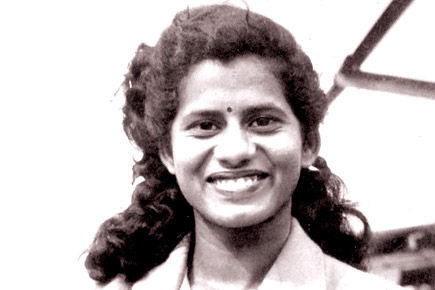A butterfly flaps its wings in the Amazon and causes a tornado in Japan. Nazi’s invades Poland and causes food shortage in India. British India rations food and causes an adolescent Mary to choose between playing field hockey and securing the rations for her family for the week. Stuck between forthcoming hunger and hockey, she went to the latter. She played well but was welcomed by the rage and lashes of her father. It would’ve been an opposite reception if he had known that her daughter would become one of the first female Olympians of the young sovereign of India. Aside from being an excellent hockey player, she became a high-calibre track and field athlete and even played table tennis and badminton for the Indian Railways. Represented India in various international events and became one of the first Indian women to win medals at multiple international sporting events. Sports was her life, but her life was unacknowledged and received no honours from the country. Such a remarkable woman was forgotten until her daughter brought her into the limelight. This is the story of Mary D’ Souza.
Mary D’ Souza was born on the 18th of July,1933 at Bombay. The seventh child of twelve born to Daigo Francis D’ Souza and Mila Greena D’ Souza. The backdrop of her childhood is painted with the oppression of the colonial regime, the cataclysm of the second world war and the horrors of the infamous partition of India. Also keeping in mind that Indian society in the mid-20th Century is terribly more prejudiced towards the feminine gender than now. Girls were actively encouraged to assist in housework rather than sports or education and this was the case with Mary and her parents too. Her father called her a tomboy as she was the only girl playing hockey with the boys. None of her family members ever came to see her events. It was her passion and love for sports that kept her going. From climbing trees with her peers and siblings to sack racing and balancing books in school, she became the champion of her convent school. Talent cannot be hidden, and soon enough, a hockey team manager recruited her. And thus, began her journey.
“I had no skills at all. So, what I did was, I paralyzed three players… Although I was not constructive, I was destructive. That’s how I started my hockey career”. It was a dominating first match, for someone with little to no knowledge of hockey. Subsequently, people started to notice her speed and were encouraged to run for athletics. The first run failed miserably. Then, she followed the top runners and copied everything they did. There was no coach to show the ropes but at the end of the very first year of training, she was already in the top three. By 1950, Mary had become a professional athlete and a hockey player.
In 1950, Jawhar Lal Nehru, the first Prime Minister of India, announced that India will host the first Asian Games. Consequently, the games were held in March 1951 at New Delhi. Mary bagged a silver medal for the 400m relay run and a bronze for the 200m race. Thereby becoming the first Indian woman to win double medals at an international sporting event. However, there was no reception in New Delhi or at home after winning the games. All she received was an autographed picture of Nehru and an autograph from Lady Mountbatten, no interviews, no press, no rewards.
The next big event after the Asian Games was the Helsinki Olympics of 1952. At that time, Mary was at the top of her game, breaking national records in 100 and 200m. And yes, our star in the making was among four women who were selected to be part of the Indian contingent. However, the training for the Olympics was an arduous process. Most of the time, they had to sleep in army tents; use holes in the ground as toilets and take showers in makeshift outdoor facilities. If that wasn’t enough, the government didn’t have enough funds to send the whole contingent. Her local club organized a dance and whist competition to raise money and with a little last-minute aid from the government, she was able to attend the summer Olympics, becoming one of the first female Olympians of the sub-continent. The female athletics team was greatly unprepared. They didn’t have a coach. The runners were not aware of starting blocks and were digging their feet into the ground for starts. Surprisingly, it was Harrison Dillard, a famous Olympic gold medallist, who gave Mary her first starting blocks. The female squad crumbled; not adored with a single medal around their necks. However, our country has come a long way from those days. In the 2020 Tokyo summer Olympics, India was able to send its largest contingent of 127 athletes out of which 56 were women. And out of the seven medals scored by the players, three were by women.
After the Helsinki fiasco, Mary was part of the first female hockey team to participate in the International Women’s World Cup held in England in 1953. Then, she was recruited by the Indian Railways on account of her excellence and dedication to games and sports. When the monsoons poured down in Bombay, outdoor games were unplayable. So, she took up badminton and table tennis and played for the railways at a national level. Recruiting players and scouting for talent for the railways became her job. And continued work for the railways, even after her marriage in 1958 until she retired at the age of 58. Now, she lives in the US with her daughter.
If you google ‘the first Indian woman to win a gold medal at the Asian Games’, it says Kamaljeet Sandhu at the 1970 Bangkok Asian Games in 400 m race. However, if you take a closer look at the medal tally of the 1954 Manila Asian Games; it was Christine Brown, Violet Peters, Mary D’ Souza and her sister Stephie D’ Souza who won the gold medal for the 400m relay, making them the first female squad to win gold at the Asian Games. Mary continued to represent India in various other events – The World Cup Hockey in Australia (1956), Sri Lanka track meet (1957), and India v/s Japan hockey (1964). She qualified for the 1956 Melbourne Olympics, but the whole woman contingent had to stay back because of a lack of funds. Her biggest disappointment was that she couldn’t qualify for the 1954 Commonwealth Games held in Canada, just because of a late start.
In 2013, Mary D’ Souza, as a result of the relentless efforts of her daughter to honour her mother’s legacy, was presented with the Dhyan Chand Award for Lifetime Achievement in Sports and Games by the Ministry of Youth Affairs and Sports at the Rashtrapati Bhavan. The Indian Minister and Sports officials apologize for not recognizing her earlier; to which she replied “I’m so glad at least I got it. I didn’t get it posthumously”.
By Shaman Chongtham
















